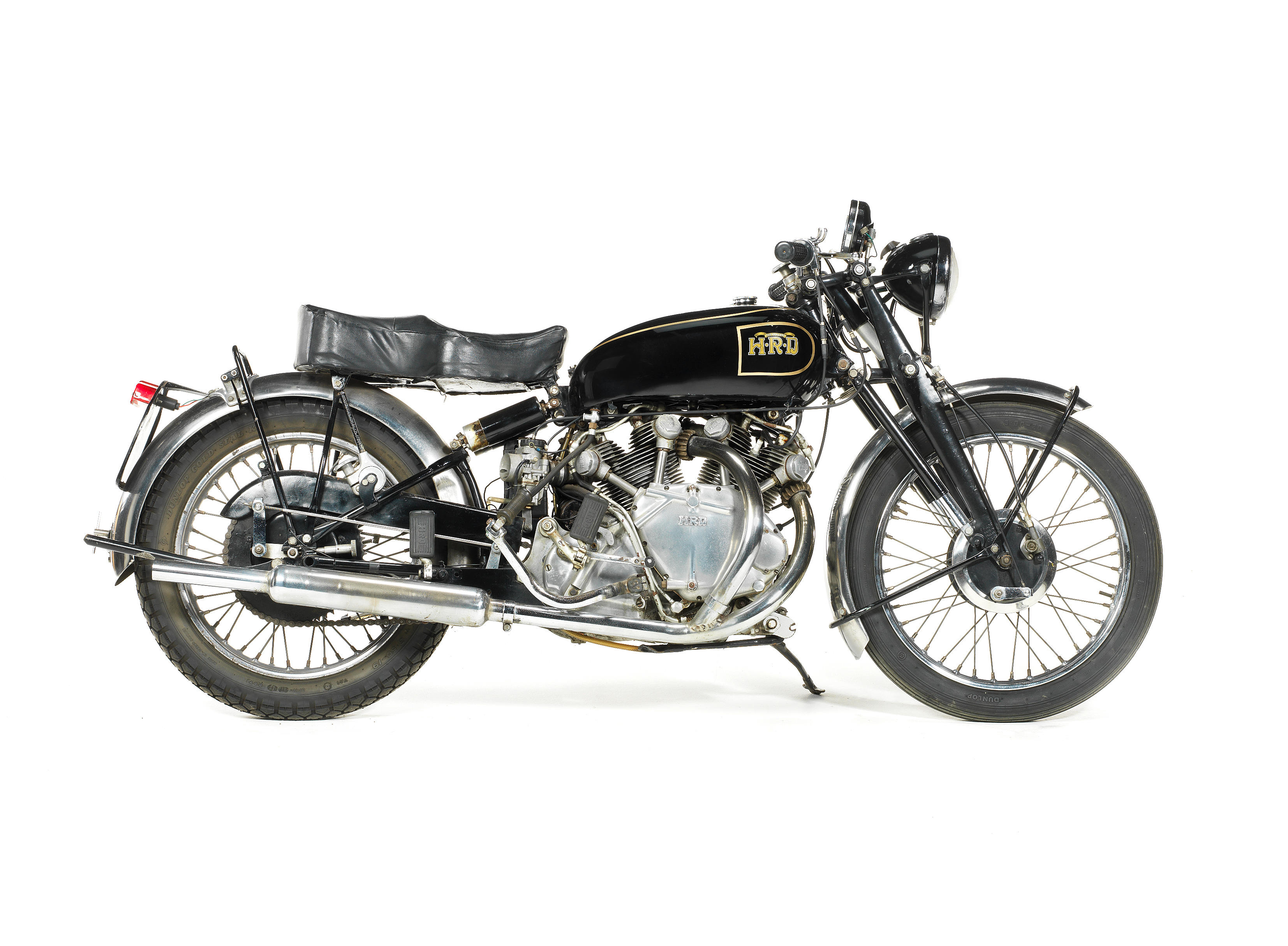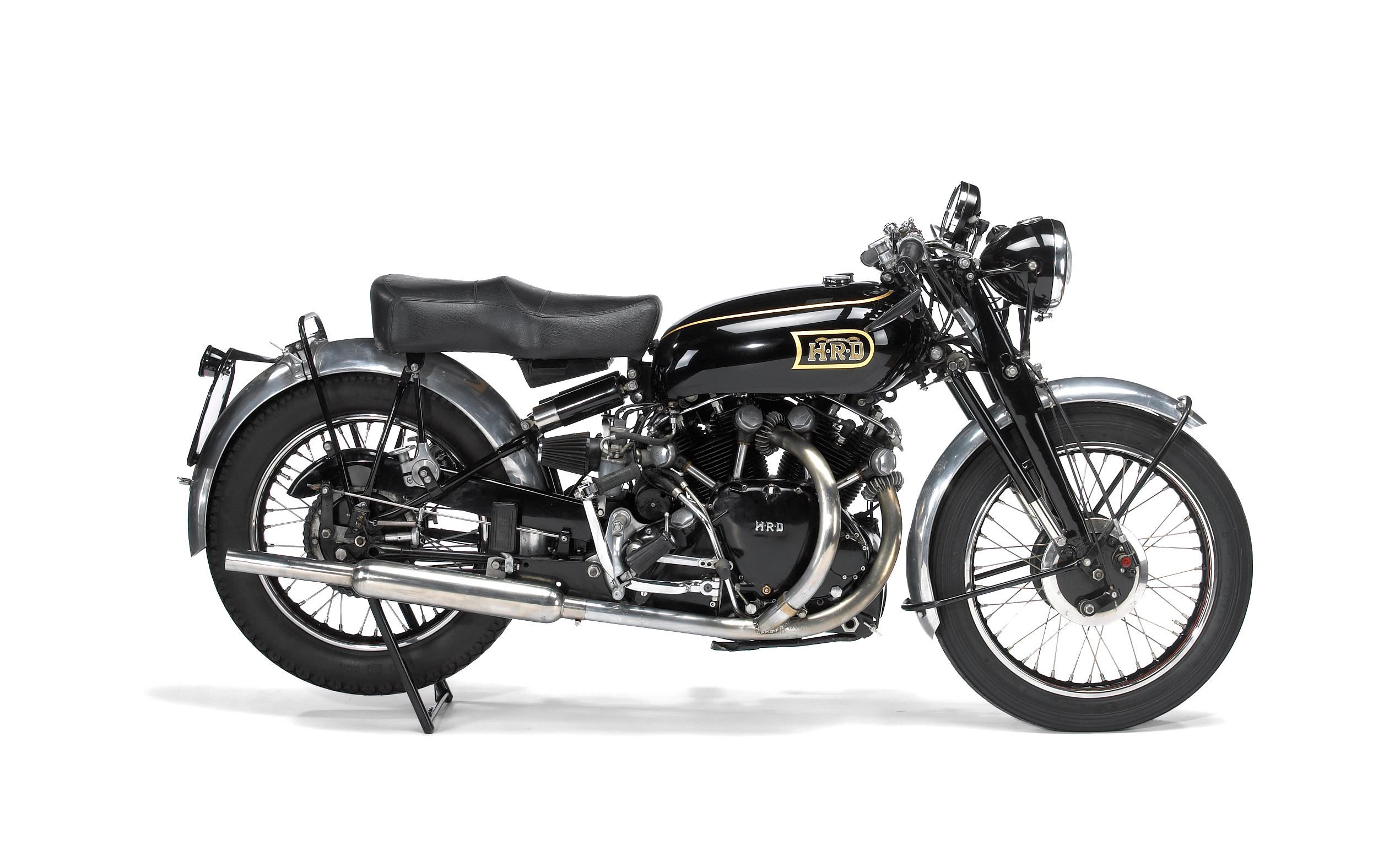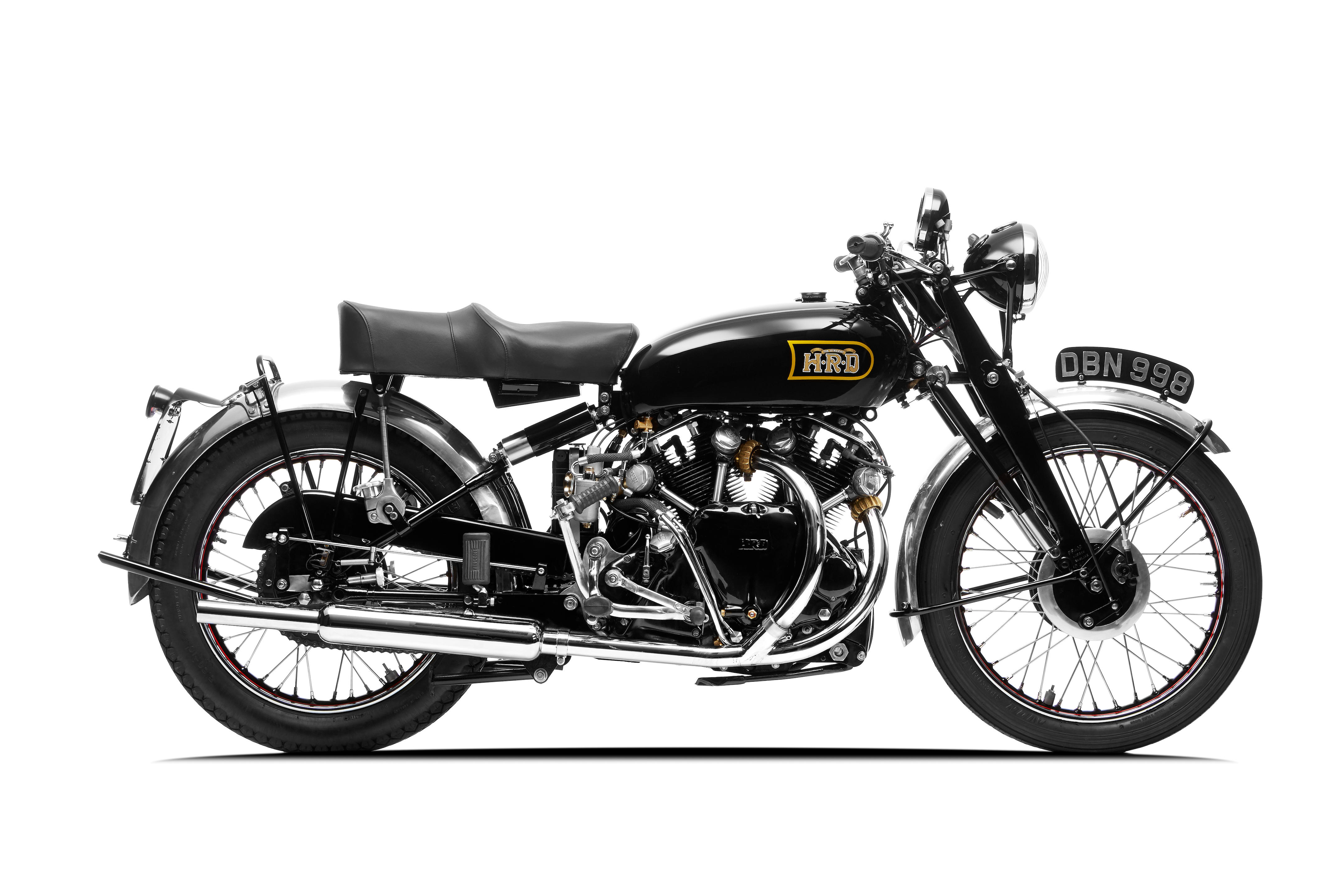Production of all Vincent Series A models ceased at the outbreak of WW2, and when the factory resumed motorcycle manufacture at the war's end it was with the all-new Series B. Its rear suspension aside, the Series A Vincent-HRD had been conventional enough: tubular steel frame, girder forks, separate gearbox, etc, but the Series B would establish the marque's reputation for the defiance of convention in the pursuit of engineering excellence. For a start there was no 'frame' as such, merely a fabricated box, attached to the cylinder heads, which served as the oil tank and incorporated the headstock and the rear springs' attachment point. The gearbox was integral with the engine, and the swinging arm pivoted directly in the engine/gearbox casings, features commonplace today but unusual 60 years ago. Only in his retention of the pre-war Brampton girder fork did Phillip Vincent appear to be lagging behind other manufacturers, almost all of which had switched to telescopics, but this apparent shortcoming would soon be addressed by the arrival of the famous 'Girdraulic' fork. Introduced in 1946, the Vincent-HRD Series-B Rapide was immediately the fastest production motorcycle on sale anywhere, with a top speed of 110mph. This particular Series B Rapide comes with a copy of the works order form recording that it left the factory equipped with Brampton forks and was destined for 'St Andrews/Newcastle'. Its late owner acquired the machine in 1970. Offered from his estate, the Vincent comes with old-style continuation logbook (issued 1968), VOC Certificate of Authenticity, old/current UK V5/V5C registration documents and sundry restoration photographs. 1949 Vincent-HRD 998 cm3 Rapide Série B N° d'immatriculation MVK 445 (UK) Cadre n° R3759 Moteur n° F10AB/1/1859 La production de tous les types Vincent Série A cessa au moment du déclenchement de la Seconde Guerre mondiale. Lorsque l'usine reprit ses fabrications de motos après 1945, ce fut en produisant la toute nouvelle Série B. A l'exception de sa suspension arrière, la Vincent-HRD Série A était une machine assez conventionnelle : cadre en tube d'acier, fourche à parallélogramme, boîte séparée, etc, mais la Série B devait établir la réputation de la marque comme championne des solutions non conventionnelles dans sa recherche de la perfection mécanique. En premier lieu, le cadre en tant que tel fut supprimé, remplacé par un boîtier mécano-soudé attaché aux culasses servant de réservoir d'huile et intégrant la douille de direction et le point d'attache des ressorts arrière. La boîte de vitesses était intégrée au moteur et le bras oscillant pivotait directement sur le carter commun, des idées répandues de nos jours, mais à l'avant-garde à l'époque. Seul le maintien de la fourche à parallélogramme Brampton d'avant guerre laissa croire que Philip Vincent était en retard par rapport aux autres constructeurs, presque tous convertis à la fourche télescopique, mais cette faiblesse apparente devait bientôt être éliminée par l'apparition de la fourche « Girdraulic ». Introduite en 1946, la Vincent-HRD Rapide Série B se classa immédiatement comme la moto de production la plus rapide du monde avec une vitesse de pointe de 176 km/h. Cette Rapide Série B est accompagnée d'une copie de la commande d'usine indiquant qu'elle fut équipée d'une fourche Brampton et destinée à « St Andrews/Newcastle ». Son dernier propriétaire l'acheta en 1970. Provenant de sa succession, la Vincent possède son ancien log-book (de 1968) récapitulant ses propriétaires, son certificat d'authenticité du VOC et ses documents d'immatriculation ancien et actuel V5/V5C complétés d'un grand nombre de photographies.
Production of all Vincent Series A models ceased at the outbreak of WW2, and when the factory resumed motorcycle manufacture at the war's end it was with the all-new Series B. Its rear suspension aside, the Series A Vincent-HRD had been conventional enough: tubular steel frame, girder forks, separate gearbox, etc, but the Series B would establish the marque's reputation for the defiance of convention in the pursuit of engineering excellence. For a start there was no 'frame' as such, merely a fabricated box, attached to the cylinder heads, which served as the oil tank and incorporated the headstock and the rear springs' attachment point. The gearbox was integral with the engine, and the swinging arm pivoted directly in the engine/gearbox casings, features commonplace today but unusual 60 years ago. Only in his retention of the pre-war Brampton girder fork did Phillip Vincent appear to be lagging behind other manufacturers, almost all of which had switched to telescopics, but this apparent shortcoming would soon be addressed by the arrival of the famous 'Girdraulic' fork. Introduced in 1946, the Vincent-HRD Series-B Rapide was immediately the fastest production motorcycle on sale anywhere, with a top speed of 110mph. This particular Series B Rapide comes with a copy of the works order form recording that it left the factory equipped with Brampton forks and was destined for 'St Andrews/Newcastle'. Its late owner acquired the machine in 1970. Offered from his estate, the Vincent comes with old-style continuation logbook (issued 1968), VOC Certificate of Authenticity, old/current UK V5/V5C registration documents and sundry restoration photographs. 1949 Vincent-HRD 998 cm3 Rapide Série B N° d'immatriculation MVK 445 (UK) Cadre n° R3759 Moteur n° F10AB/1/1859 La production de tous les types Vincent Série A cessa au moment du déclenchement de la Seconde Guerre mondiale. Lorsque l'usine reprit ses fabrications de motos après 1945, ce fut en produisant la toute nouvelle Série B. A l'exception de sa suspension arrière, la Vincent-HRD Série A était une machine assez conventionnelle : cadre en tube d'acier, fourche à parallélogramme, boîte séparée, etc, mais la Série B devait établir la réputation de la marque comme championne des solutions non conventionnelles dans sa recherche de la perfection mécanique. En premier lieu, le cadre en tant que tel fut supprimé, remplacé par un boîtier mécano-soudé attaché aux culasses servant de réservoir d'huile et intégrant la douille de direction et le point d'attache des ressorts arrière. La boîte de vitesses était intégrée au moteur et le bras oscillant pivotait directement sur le carter commun, des idées répandues de nos jours, mais à l'avant-garde à l'époque. Seul le maintien de la fourche à parallélogramme Brampton d'avant guerre laissa croire que Philip Vincent était en retard par rapport aux autres constructeurs, presque tous convertis à la fourche télescopique, mais cette faiblesse apparente devait bientôt être éliminée par l'apparition de la fourche « Girdraulic ». Introduite en 1946, la Vincent-HRD Rapide Série B se classa immédiatement comme la moto de production la plus rapide du monde avec une vitesse de pointe de 176 km/h. Cette Rapide Série B est accompagnée d'une copie de la commande d'usine indiquant qu'elle fut équipée d'une fourche Brampton et destinée à « St Andrews/Newcastle ». Son dernier propriétaire l'acheta en 1970. Provenant de sa succession, la Vincent possède son ancien log-book (de 1968) récapitulant ses propriétaires, son certificat d'authenticité du VOC et ses documents d'immatriculation ancien et actuel V5/V5C complétés d'un grand nombre de photographies.















Try LotSearch and its premium features for 7 days - without any costs!
Be notified automatically about new items in upcoming auctions.
Create an alert